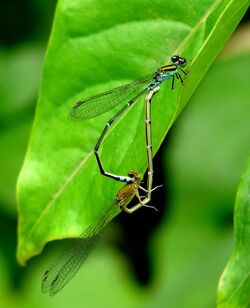Biology:Pseudagrion indicum
| Pseudagrion indicum | |
|---|---|

| |
| male | |

| |
| mating pair | |
| Scientific classification | |
| Domain: | Eukaryota |
| Kingdom: | Animalia |
| Phylum: | Arthropoda |
| Class: | Insecta |
| Order: | Odonata |
| Suborder: | Zygoptera |
| Family: | Coenagrionidae |
| Genus: | Pseudagrion |
| Species: | P. indicum
|
| Binomial name | |
| Pseudagrion indicum Fraser, 1924
| |
Pseudagrion indicum,[2][1] yellow-striped blue dart[3] or yellow-striped dart,[4] is a species of damselfly in the family Coenagrionidae. It is found only in Western Ghats of India .[1][5]
Description and habitat
It is a medium sized damselfly with black-capped greenish eyes. Its thorax is black on dorsum with black humeral stripes; the area between them is pale green. The lateral sides are azure blue. Abdominal segments 1 and 2 are azure blue with black marks on the dorsum. Mark on segment 2 looks like a chalice or thistle-head. Segments 3 to 7 are black on dorsum and pale green on the sides. Segments 8 and 9 are azure blue with black apical annules. Segment 10 is black.[6]
Female has yellowish green thorax and green eyes capped with yellowish green. Color of the abdomen is similar to the male; but paler. Segments 8 and 9 are also black with fine apical blue rings. Segment 10 is blue.[6]
It breeds in small streams and associated marshes in sub-montane and montane areas of the Western Ghats.[6][7][8][3][4]
See also
- List of odonates of India
- List of odonata of Kerala
References
- ↑ 1.0 1.1 1.2 Dow, R.A. (2020). "Pseudagrion indicum". IUCN Red List of Threatened Species 2020: e.T163676A138282477. doi:10.2305/IUCN.UK.2020-1.RLTS.T163676A138282477.en. https://www.iucnredlist.org/species/163676/138282477. Retrieved 18 November 2021.
- ↑ "World Odonata List". University of Puget Sound. https://www.pugetsound.edu/academics/academic-resources/slater-museum/biodiversity-resources/dragonflies/world-odonata-list2/.
- ↑ 3.0 3.1 "Pseudagrion indicum Fraser, 1924". India Biodiversity Portal. http://indiabiodiversity.org/species/show/228177.
- ↑ 4.0 4.1 "Pseudagrion indicum Fraser, 1924". Odonata of India, v. 1.00. Indian Foundation for Butterflies. http://www.indianodonata.org/sp/392/Pseudagrion-indicum.
- ↑ K.A., Subramanian; K.G., Emiliyamma; R., Babu; C., Radhakrishnan; S.S., Talmale (2018). Atlas of Odonata (Insecta) of the Western Ghats, India. Zoological Survey of India. pp. 169–170. ISBN 9788181714954.
- ↑ 6.0 6.1 6.2 C FC Lt. Fraser (1933). The Fauna of British India, including Ceylon and Burma, Odonata Vol. I. Red Lion Court, Fleet Street, London: Taylor and Francis. pp. 303-304. https://archive.org/details/FraserOdonata1.
- ↑ C FC Lt. Fraser (1924). A Survey of the Odonate (Dragonfly) Fauna of Western India and Descriptions of Thirty New Species. pp. 495–496. http://faunaofindia.nic.in/PDFVolumes/records/026/05/0423-0522.pdf.
- ↑ Subramanian, K. A. (2005). Dragonflies and Damselflies of Peninsular India - A Field Guide. http://www.ias.ac.in/Publications/Overview/Dragonflies.
External links
Wikidata ☰ Q2639316 entry
 |


